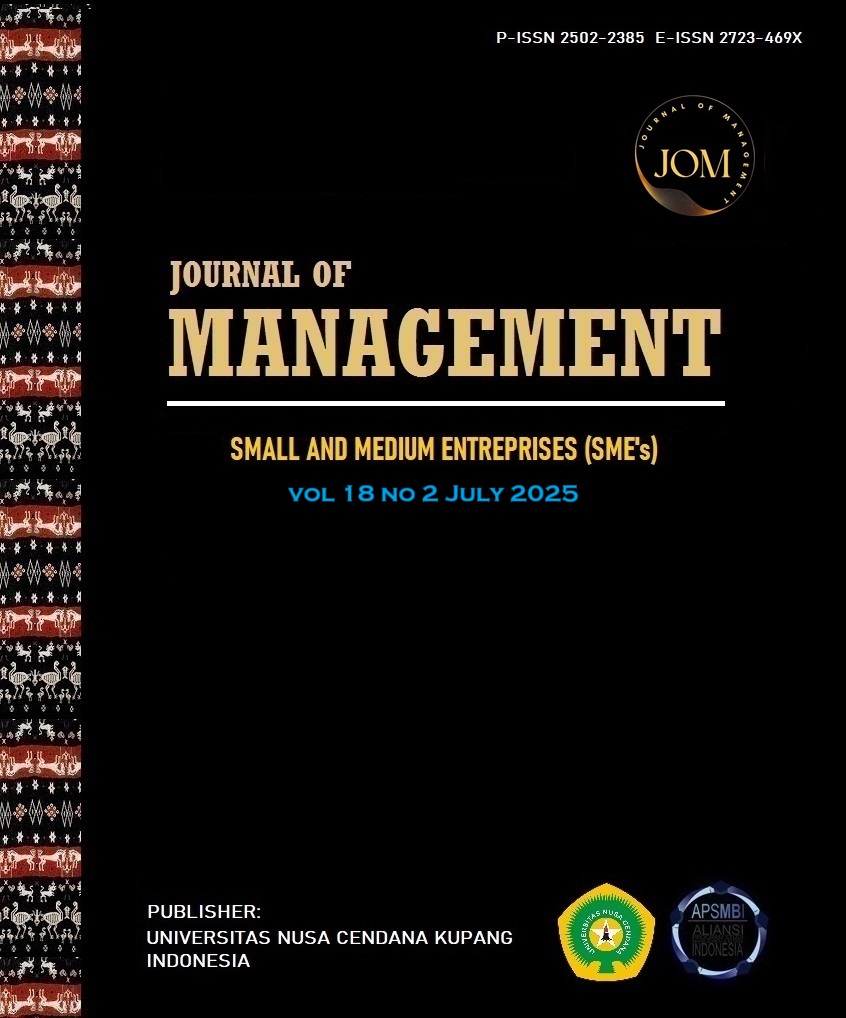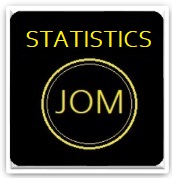A RELATIONS BETWEEN GREEN HUMAN RESORCE MANAGEMENT (GHRM) AND ENVIRONMENTALLY FRIENDLY BEHAVIOR : PERCEPTIONS OF STUDENTS AS PROSPECTIVE EMPLOYEES
Abstract
This study examines the relationship between Green Human Resource Management (GHRM) practices and environmentally friendly behavior among students of Raden Mas Said State Islamic University Surakarta as prospective employees. The study employed a quantitative cross-sectional method, analyzing data from 160 students using Structural Equation Modeling (SEM) with Partial Least Squares. Results indicate that GHRM positively influences both task-related and voluntary green behaviors. Specifically, Green Recrutment and Selections (GRS), Green Performance Management (GPM), and Green Compensation management (GCM) significantly affect task-related behavior, while GRS, Green Training and Development (GTD), GPM, and Green Employee Involement (GEI) impact voluntary behavior. Green psychological climate mediates this relationship, though its indirect effects were weaker than expected. These findings highlight GHRM's role in promoting green behaviors among prospective employees, offering insights for organizations seeking to attract environmentally conscious talent. The study contributes empirical evidence on GHRM's impact from the perspective of future employees.
Keywords : Green Human Resource Management ; Employee Green Behavior ; Green Psychology Climate ; Green Recrutmen and Selection ; Green Training and Development ; Green Performance Management ; Green Compensation management ; Green Employee Involement
Downloads
References
https://doi.org/10.1016/j.heliyon.2023.e19134
Antika, R., & Suryani, T. (2024). Pengaruh manajemen sumber daya manusia ramah lingkungan terhadap perilaku green service dengan tanggung jawab sosial perusahaan sebagai pemediasi. Jurnal Manajemen Strategi Dan Aplikasi Bisnis, 7(1), 121–136. https://doi.org/10.36407/jmsab.v7i1.1188
Benraïss-Noailles, L., Herrbach, O., & Viot, C. (2021). The impact of CSR perceptions on employer attractiveness: an empirical study. Question(s) de Management, n° 32(2), 15–24. https://doi.org/10.3917/qdm.212.0015
Bissing‐Olson, M. J., Iyer, A., Fielding, K. S., & Zacher, H. (2013). Relationships between daily affect and pro‐environmental behavior at work: The moderating role of pro‐environmental attitude. Journal of Organizational Behavior, 34(2), 156–175.
Cheema, S., Afsar, B., & Javed, F. (2020). Employees’ corporate social responsibility perceptions and organizational citizenship behaviors for the environment: The mediating roles of organizational identification and environmental orientation fit. Corporate Social Responsibility and Environmental Management, 27(1), 9–21.
Chiappetta Jabbour, C. J., Sarkis, J., Lopes de Sousa Jabbour, A. B., Scott Renwick, D. W., Singh, S. K., Grebinevych, O., Kruglianskas, I., & Filho, M. G. (2019). Who is in charge? A review and a research agenda on the ‘human side’ of the circular economy. Journal of Cleaner Production, 222, 793–801. https://doi.org/10.1016/j.jclepro.2019.03.038
Djellal, F., & Gallouj, F. (2016). Service innovation for sustainability: paths for greening through service innovation. Springer.
Dumont, J., Shen, J., & Deng, X. (2017). Effects of green HRM practices on employee workplace green behavior: The role of psychological green climate and employee green values. Human Resource Management, 56(4), 613–627.
Ercantan, O., & Eyupoglu, S. (2022). How Do Green Human Resource Management Practices Encourage Employees to Engage in Green Behavior? Perceptions of University Students as Prospective Employees. Sustainability (Switzerland), 14(3). https://doi.org/10.3390/su14031718
Febrianty, S. E., & Muhammad, S. (2023). Manajemen Sumber Daya Manusia yang Pro Gen Z. UPPM universitas malahayati.
Hair, J. F., Black, W. C., Babin, B. J., & Anderson, R. E. (2010). Multivariate data analysis: Global edition. NJ: Pearson Higher Education Upper Saddle River.
Hair, J. F., Risher, J. J., Sarstedt, M., & Ringle, C. M. (2019). When to use and how to report the results of PLS-SEM. European Business Review, 31(1), 2–24. https://doi.org/10.1108/EBR-11-2018-0203
Hanna, M. D., Rocky Newman, W., & Johnson, P. (2000). Linking operational and environmental improvement through employee involvement. International Journal of Operations & Production Management, 20(2), 148–165.
Hanson-Rasmussen, N., Lauver, K., & Lester, S. (2014). Business student perceptions of environmental sustainability: Examining the job search implications. Journal of Managerial Issues, 174–193.
Haryono, S. (2017). Metode SEM untuk penelitian manajemen dengan AMOS LISREL PLS. Luxima Metro Media, 450.
Ilham, I., & Widodo, H. (2021). The Role of Green Accounting in Efforts to Prevent Environmental Pollution to Support Business Continuity. Academia Open, 5, 1–13. https://doi.org/10.21070/acopen.5.2021.2490
Isrososiawan, S., Rahayu, A., Wibowo, L. A., & Dewatmoko, S. (2020). Green Human Resources Management Mendukung Kinerja Lingkungan Industri Perhotelan. Jurnal Co Management, 3(2), 457–470.
https://Doi.Org/10.32670/Comanagement.V3i2.425comanagement.V3i2.425, 457–470.
Jamal, T., Zahid, M., Martins, J. M., Mata, M. N., Rahman, H. U., & Mata, P. N. (2021). Perceived green human resource management practices and corporate sustainability: Multigroup analysis and major industries perspectives. Sustainability (Switzerland), 13(6), 1–17.
https://doi.org/10.3390/su13063045
Kangasniemi, M., Kallio, H., & Pietilä, A. (2014). Towards environmentally responsible nursing: a critical interpretive synthesis. Journal of Advanced Nursing, 70(7), 1465–1478.
Lamm, E., Tosti-Kharas, J., & Williams, E. G. (2013). Read This Article, but Don’t Print It: Organizational Citizenship Behavior Toward the Environment. Group & Organization Management, 38(2), 163–197.
https://doi.org/10.1177/1059601112475210
Li, W., Abdalla, A. A., Mohammad, T., Khassawneh, O., & Parveen, M. (2023). Towards Examining the Link Between Green HRM Practices and Employee Green in-Role Behavior: Spiritual Leadership as a Moderator. Psychology Research and Behavior Management, 16, 383–396. https://doi.org/10.2147/PRBM.S396114
Makarim, A. F. (2021). Pengaruh Praktik Green Human Resource Management (GHRM) Terhadap Turnover Intentions Dimediasi Lingkungan Kerja. 11. https://dspace.uii.ac.id/handle/123456789/34159
Mishra, P. (2017). Green human resource management. International Journal of Organizational Analysis, 25(5), 762–788. https://doi.org/10.1108/IJOA-11-2016-1079
Muchtadin, M. (2022). Hubungan Manajemen Sumber Daya Manusia Hijau dan Kinerja Berkelanjutan: Tinjauan Literatur. Jurnal Doktor Manajemen (JDM), 5(1), 54.
Norton, T. A., Parker, S. L., Zacher, H., & Ashkanasy, N. M. (2015). Employee green behavior: A theoretical framework, multilevel review, and future research agenda. Organization & Environment, 28(1), 103–125.
Novie, D., Arta, C., Leuhery, F., Abubakar, H., Yusuf, M., Cakranegara, P. A., Jayapura, P. P., Pattimura, U., Bosowa, U., Bandung, S., & Presiden, U. (2023). Literature Review: Analysis of the Relationship Between Training and Employee Performance in a Company Literature Review: Analisis Hubungan Antara Pelatihan dan Kinerja Karyawan di Sebuah Perusahaan. Management Studies and Entrepreneurship Journal, 4(1), 162–168.
http://journal.yrpipku.com/index.php/msej
Perron, G. M., Côté, R. P., & Duffy, J. F. (2006). Improving environmental awareness training in business. Journal of Cleaner Production, 14(6), 551–562. https://doi.org/https://doi.org/10.1016/j.jclepro.2005.07.006
Pham, N. T., Tučková, Z., & Phan, Q. P. T. (2019). Greening human resource management and employee commitment toward the environment: an interaction model. Journal of Business Economics and Management, 20(3), 446–465.
Purnomo, A. K. (2021). Analisis Penerapan Green Human Resource Management Pada Perusahaan Tekstil. Mbia, 20(2), 177–185.
https://doi.org/10.33557/mbia.v20i2.1416
Purwanto, A., & Sudargini, Y. (2021). Partial Least Squares Structural Squation Modeling ( PLS-SEM ) Analysis for Social and Management Research : A Literature Review Journal of Industrial Engineering & Management Research. 2(4), 114–123.
Rael J. M. (2018). Influence of Green Reward and Compensation Practice on Environmental Sustainability in Selected Service Based State …. European Journal of Business and Strategic …, 3(6), 1–12.
Raharjo, S. B., & Wening, N. (2023). Green human resource management dalam rekrutmen dan pelatihan karyawan. Entrepreneurship Bisnis Manajemen Akuntansi (E-BISMA), 4(2), 350–359.
https://doi.org/10.37631/ebisma.v4i2.1186
Renwick, D., Redman, T., & Maguire, S. (2008). Green HRM: A review, process model, and research agenda. University of Sheffield Management School Discussion Paper, 1(1), 1–46.
Sabokro, M., Masud, M. M., & Kayedian, A. (2021). The effect of green human resources management on corporate social responsibility, green psychological climate and employees’ green behavior. Journal of Cleaner Production, 313, 127963.
Sarstedt, M., Ringle, C. M., & Hair, J. F. (2021). Partial least squares structural equation modeling. In Handbook of market research (pp. 587–632). Springer.
Scherbaum, C. A., Popovich, P. M., & Finlinson, S. (2008). Exploring individual‐level factors related to employee energy‐conservation behaviors at work 1. Journal of Applied Social Psychology, 38(3), 818–835.
Siburian, N. A., & Sugiarto*, A. (2022). Implementasi Praktik Green Human Resources Management. JURISMA : Jurnal Riset Bisnis & Manajemen, 12(2), 336–360. https://doi.org/10.34010/jurisma.v12i2.5973
Supriatna, J. (2021). Pengelolaan lingkungan berkelanjutan. Yayasan Pustaka Obor Indonesia.
Tahir, R., Athar, M. R., & Afzal, A. (2020). The impact of greenwashing practices on green employee behaviour: Mediating role of employee value orientation and green psychological climate. Cogent Business and Management, 7(1). https://doi.org/10.1080/23311975.2020.1781996
Teguh, K. A. H. A. (2022). Perilaku Ramah Lingkungan Anggota Kepolisian Negara Republik Indonesia: Sebuah Tinjauan Literatur. Jurnal Ilmu Kepolisian, 15(3), 19. https://doi.org/10.35879/jik.v15i3.344
Tentama, F., & Situmorang, N. Z. (2019). Pengujian validitas dan reliabilitas konstruk hope. Jurnal Psikologi Terapan Dan Pendidikan ISSN: 2715-2456, Vol. 1, No, 128–135.
Uslu, F., Keles, A., Aytekin, A., Yayla, O., Keles, H., Ergun, G. S., & Tarinc, A. (2023). Effect of Green Human Resource Management on Green Psychological Climate and Environmental Green Behavior of Hotel Employees: The Moderator Roles of Environmental Sensitivity and Altruism. Sustainability (Switzerland), 15(7). https://doi.org/10.3390/su15076017
Utama, E. P., Meiliani, & Anggarawati, S. (2022). Praktik Green Human Resource Management Pada Pt Bank Bengkulu. Student Journal of Business and Management, 5(3 SE-Articles), 837–861.
https://ejournal.unib.ac.id/sjbm/article/view/25831
Younis, Z., & Hussain, S. (2023). Green Transformational Leadership: Bridging the gap between Green HRM Practices and Environmental Performance through Green Psychological Climate. Sustainable Futures, 6(August), 100140. https://doi.org/10.1016/j.sftr.2023.100140
Yusoff, Y. M. (2019). Linking Green Human Resource Management Bundle to Environmental Performance in Malaysia ’ s Hotel Industry : The Mediating Role of Organizational Citizenship Behaviour Towards Environment. 9, 1625–1630. https://doi.org/10.35940/ijitee.I3340.0789S319

 Muhammad Faiq Zamzammi(1*)
Muhammad Faiq Zamzammi(1*)



